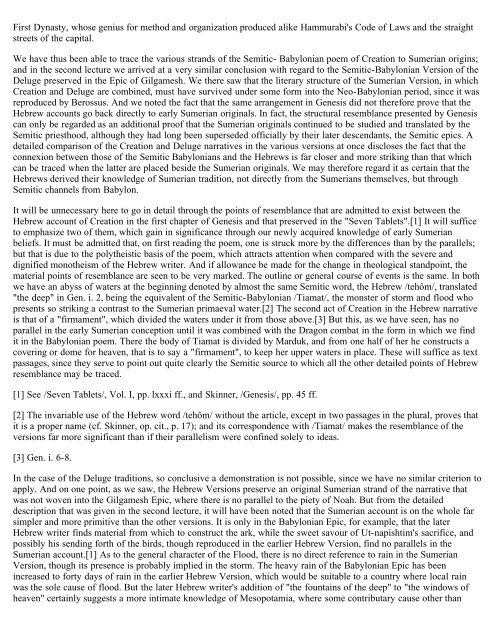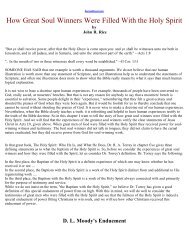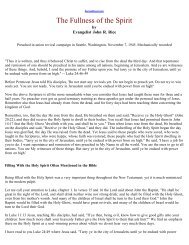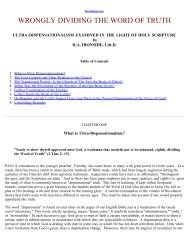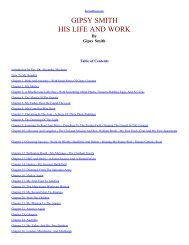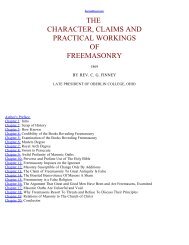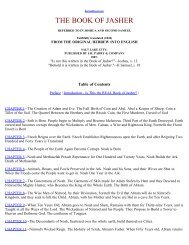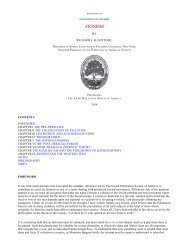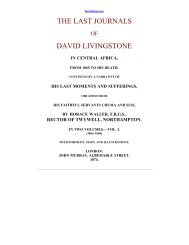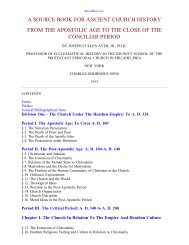Legends of Babylon and Egypt in Relation to Hebrew Tradition.pdf
Legends of Babylon and Egypt in Relation to Hebrew Tradition.pdf
Legends of Babylon and Egypt in Relation to Hebrew Tradition.pdf
Create successful ePaper yourself
Turn your PDF publications into a flip-book with our unique Google optimized e-Paper software.
First Dynasty, whose genius for method <strong>and</strong> organization produced alike Hammurabi's Code <strong>of</strong> Laws <strong>and</strong> the straight<br />
streets <strong>of</strong> the capital.<br />
We have thus been able <strong>to</strong> trace the various str<strong>and</strong>s <strong>of</strong> the Semitic- <strong>Babylon</strong>ian poem <strong>of</strong> Creation <strong>to</strong> Sumerian orig<strong>in</strong>s;<br />
<strong>and</strong> <strong>in</strong> the second lecture we arrived at a very similar conclusion with regard <strong>to</strong> the Semitic-<strong>Babylon</strong>ian Version <strong>of</strong> the<br />
Deluge preserved <strong>in</strong> the Epic <strong>of</strong> Gilgamesh. We there saw that the literary structure <strong>of</strong> the Sumerian Version, <strong>in</strong> which<br />
Creation <strong>and</strong> Deluge are comb<strong>in</strong>ed, must have survived under some form <strong>in</strong><strong>to</strong> the Neo-<strong>Babylon</strong>ian period, s<strong>in</strong>ce it was<br />
reproduced by Berossus. And we noted the fact that the same arrangement <strong>in</strong> Genesis did not therefore prove that the<br />
<strong>Hebrew</strong> accounts go back directly <strong>to</strong> early Sumerian orig<strong>in</strong>als. In fact, the structural resemblance presented by Genesis<br />
can only be regarded as an additional pro<strong>of</strong> that the Sumerian orig<strong>in</strong>als cont<strong>in</strong>ued <strong>to</strong> be studied <strong>and</strong> translated by the<br />
Semitic priesthood, although they had long been superseded <strong>of</strong>ficially by their later descendants, the Semitic epics. A<br />
detailed comparison <strong>of</strong> the Creation <strong>and</strong> Deluge narratives <strong>in</strong> the various versions at once discloses the fact that the<br />
connexion between those <strong>of</strong> the Semitic <strong>Babylon</strong>ians <strong>and</strong> the <strong>Hebrew</strong>s is far closer <strong>and</strong> more strik<strong>in</strong>g than that which<br />
can be traced when the latter are placed beside the Sumerian orig<strong>in</strong>als. We may therefore regard it as certa<strong>in</strong> that the<br />
<strong>Hebrew</strong>s derived their knowledge <strong>of</strong> Sumerian tradition, not directly from the Sumerians themselves, but through<br />
Semitic channels from <strong>Babylon</strong>.<br />
It will be unnecessary here <strong>to</strong> go <strong>in</strong> detail through the po<strong>in</strong>ts <strong>of</strong> resemblance that are admitted <strong>to</strong> exist between the<br />
<strong>Hebrew</strong> account <strong>of</strong> Creation <strong>in</strong> the first chapter <strong>of</strong> Genesis <strong>and</strong> that preserved <strong>in</strong> the "Seven Tablets".[1] It will suffice<br />
<strong>to</strong> emphasize two <strong>of</strong> them, which ga<strong>in</strong> <strong>in</strong> significance through our newly acquired knowledge <strong>of</strong> early Sumerian<br />
beliefs. It must be admitted that, on first read<strong>in</strong>g the poem, one is struck more by the differences than by the parallels;<br />
but that is due <strong>to</strong> the polytheistic basis <strong>of</strong> the poem, which attracts attention when compared with the severe <strong>and</strong><br />
dignified monotheism <strong>of</strong> the <strong>Hebrew</strong> writer. And if allowance be made for the change <strong>in</strong> theological st<strong>and</strong>po<strong>in</strong>t, the<br />
material po<strong>in</strong>ts <strong>of</strong> resemblance are seen <strong>to</strong> be very marked. The outl<strong>in</strong>e or general course <strong>of</strong> events is the same. In both<br />
we have an abyss <strong>of</strong> waters at the beg<strong>in</strong>n<strong>in</strong>g denoted by almost the same Semitic word, the <strong>Hebrew</strong> /tehôm/, translated<br />
"the deep" <strong>in</strong> Gen. i. 2, be<strong>in</strong>g the equivalent <strong>of</strong> the Semitic-<strong>Babylon</strong>ian /Tiamat/, the monster <strong>of</strong> s<strong>to</strong>rm <strong>and</strong> flood who<br />
presents so strik<strong>in</strong>g a contrast <strong>to</strong> the Sumerian primaeval water.[2] The second act <strong>of</strong> Creation <strong>in</strong> the <strong>Hebrew</strong> narrative<br />
is that <strong>of</strong> a "firmament", which divided the waters under it from those above.[3] But this, as we have seen, has no<br />
parallel <strong>in</strong> the early Sumerian conception until it was comb<strong>in</strong>ed with the Dragon combat <strong>in</strong> the form <strong>in</strong> which we f<strong>in</strong>d<br />
it <strong>in</strong> the <strong>Babylon</strong>ian poem. There the body <strong>of</strong> Tiamat is divided by Marduk, <strong>and</strong> from one half <strong>of</strong> her he constructs a<br />
cover<strong>in</strong>g or dome for heaven, that is <strong>to</strong> say a "firmament", <strong>to</strong> keep her upper waters <strong>in</strong> place. These will suffice as text<br />
passages, s<strong>in</strong>ce they serve <strong>to</strong> po<strong>in</strong>t out quite clearly the Semitic source <strong>to</strong> which all the other detailed po<strong>in</strong>ts <strong>of</strong> <strong>Hebrew</strong><br />
resemblance may be traced.<br />
[1] See /Seven Tablets/, Vol. I, pp. lxxxi ff., <strong>and</strong> Sk<strong>in</strong>ner, /Genesis/, pp. 45 ff.<br />
[2] The <strong>in</strong>variable use <strong>of</strong> the <strong>Hebrew</strong> word /tehôm/ without the article, except <strong>in</strong> two passages <strong>in</strong> the plural, proves that<br />
it is a proper name (cf. Sk<strong>in</strong>ner, op. cit., p. 17); <strong>and</strong> its correspondence with /Tiamat/ makes the resemblance <strong>of</strong> the<br />
versions far more significant than if their parallelism were conf<strong>in</strong>ed solely <strong>to</strong> ideas.<br />
[3] Gen. i. 6-8.<br />
In the case <strong>of</strong> the Deluge traditions, so conclusive a demonstration is not possible, s<strong>in</strong>ce we have no similar criterion <strong>to</strong><br />
apply. And on one po<strong>in</strong>t, as we saw, the <strong>Hebrew</strong> Versions preserve an orig<strong>in</strong>al Sumerian str<strong>and</strong> <strong>of</strong> the narrative that<br />
was not woven <strong>in</strong><strong>to</strong> the Gilgamesh Epic, where there is no parallel <strong>to</strong> the piety <strong>of</strong> Noah. But from the detailed<br />
description that was given <strong>in</strong> the second lecture, it will have been noted that the Sumerian account is on the whole far<br />
simpler <strong>and</strong> more primitive than the other versions. It is only <strong>in</strong> the <strong>Babylon</strong>ian Epic, for example, that the later<br />
<strong>Hebrew</strong> writer f<strong>in</strong>ds material from which <strong>to</strong> construct the ark, while the sweet savour <strong>of</strong> Ut-napishtim's sacrifice, <strong>and</strong><br />
possibly his send<strong>in</strong>g forth <strong>of</strong> the birds, though reproduced <strong>in</strong> the earlier <strong>Hebrew</strong> Version, f<strong>in</strong>d no parallels <strong>in</strong> the<br />
Sumerian account.[1] As <strong>to</strong> the general character <strong>of</strong> the Flood, there is no direct reference <strong>to</strong> ra<strong>in</strong> <strong>in</strong> the Sumerian<br />
Version, though its presence is probably implied <strong>in</strong> the s<strong>to</strong>rm. The heavy ra<strong>in</strong> <strong>of</strong> the <strong>Babylon</strong>ian Epic has been<br />
<strong>in</strong>creased <strong>to</strong> forty days <strong>of</strong> ra<strong>in</strong> <strong>in</strong> the earlier <strong>Hebrew</strong> Version, which would be suitable <strong>to</strong> a country where local ra<strong>in</strong><br />
was the sole cause <strong>of</strong> flood. But the later <strong>Hebrew</strong> writer's addition <strong>of</strong> "the founta<strong>in</strong>s <strong>of</strong> the deep" <strong>to</strong> "the w<strong>in</strong>dows <strong>of</strong><br />
heaven" certa<strong>in</strong>ly suggests a more <strong>in</strong>timate knowledge <strong>of</strong> Mesopotamia, where some contributary cause other than


